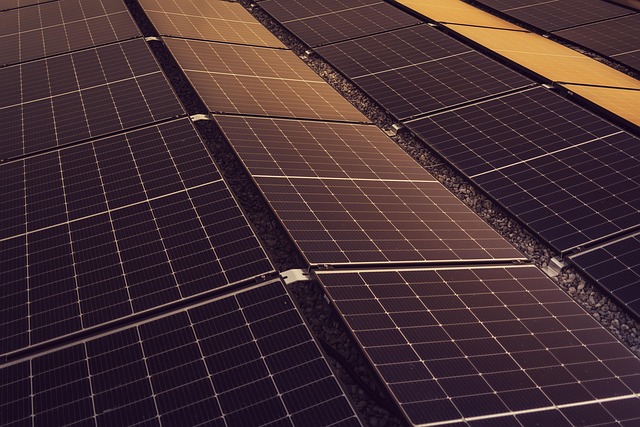Commercial solar panels empower businesses to reduce energy costs while boosting sustainability and resilience. Tailored installations from expert providers deliver high-efficiency systems with long-term warranties, maximizing ROI. Understanding installation steps, costs, and financing options helps companies confidently transition to reliable solar energy solutions designed for commercial needs and significant environmental impact.
Overview of Commercial Solar Panel Solutions for Businesses
Solar Panels for Businesses are essential components of commercial photovoltaic systems, comprising high-efficiency solar modules, inverters, mounting structures, and monitoring tools. Tailoring solar solutions to specific sectors enhances effectiveness, from retail parks to manufacturing plants.
In parallel : Unlocking Success: Leveraging AI for Enhanced Client Campaigns at a Sheffield Marketing Agency
Commercial solar panels generally provide substantial cost savings by reducing dependence on grid energy, which often costs 20-25 pence per kWh. Installing a system can significantly decrease operational expenses, often delivering electricity at just 4-5 pence per kWh. The typical project scope varies from small 5 kW setups to large-scale 50 kW systems, with costs influenced by roof type, system size, and installation complexity.
Furthermore, businesses benefit from potential tax incentives and grants, though these have become limited since 2021. Proper system design considers factors like shading, tilt, and orientation to maximize output and ROI. The integration with energy storage solutions, like batteries, can enhance energy resilience, though their cost-effectiveness remains debated.
Also to see : Maximize your project's success: hire timber mats today
Consulting experienced commercial solar panel installers ensures high-quality setup, backed by warranties of up to 25 years. As seen in case studies, these investments recoup costs within a few years and contribute to sustainability goals.
Advantages of Installing Commercial Solar Systems
Cost Savings and Financial Advantages
Commercial solar power benefits begin with substantial reductions in operating costs. For many enterprises, energy cost savings with business solar systems translate to immediate relief: generating electricity on-site allows businesses to purchase less from the grid, locking in rates as low as 4-5 pence per kWh compared to current grid charges of 20-25 pence. Return on investment is often realised within 3 to 5 years, depending on system size and usage, with larger installations leveraging economies of scale. Government support, including tax credits and accelerated investment allowances, further enhances the financial appeal, trimming payback periods and boosting long-term returns.
Sustainability and Environmental Benefits
Switching to commercial solar energy solutions goes beyond economics—the environmental impact of commercial solar is measurable and direct. By reducing demand for fossil-fuel-based electricity, businesses see real decreases in their carbon footprint. Case studies document how even mid-sized installations can offset tens to hundreds of tonnes of CO2 annually, aligning operations with corporate social responsibility goals and helping meet net zero commitments.
Enhancing Energy Independence and Resilience
Adopting commercial solar energy solutions fosters business energy independence and operational resilience. Off-grid commercial solar options and battery storage create a buffer against power outages, while integrated solar management enables businesses to flexibly control and forecast demand. This independence translates to measurable reliability and competitive advantage for operations.
Key Considerations for Commercial Solar System Design and Installation
Site Assessment and Space Optimization
A precise site assessment is the first step when exploring commercial solar system design considerations. Evaluating the roof condition, overall structure, and available area directly affects solar installation for commercial properties. Proper assessment identifies obstructions and shading that can impact factors affecting solar panel output in business settings. Maximizing rooftop space, while meeting structural and wind load requirements, can significantly boost commercial solar energy solutions and output, particularly in settings such as warehouses or office buildings.
Regulatory Compliance and Permitting
Understanding the regulatory landscape is essential in commercial photovoltaic systems overview. Regularly, planning permissions hinge on system size, building status, and location—especially for heritage sites or listed properties. Staying informed on approvals from local authorities and DNOs prevents delays and ensures commercial solar installation permits and process requirements are met. This careful approach is vital for commercial solar energy audits and keeping the project compliant and efficient.
Technical Specifications and Equipment Selection
Selecting equipment for solar power for business buildings involves balancing panel efficiency, inverter compatibility, and storage integration. High-output modules, such as 435W panels, are now the benchmark in commercial solar power benefits. Modern inverters and suitable mounting systems ensure longevity and adaptability, critical for the lifecycle and performance of commercial renewable energy policies. Each component must be chosen with energy cost savings with business solar systems and projected return on investment in mind.
Selecting Reputable Commercial Solar Providers
Criteria for Evaluating Installers
Begin with measurable standards. Choosing commercial solar installers with recognised industry certifications like ISO, NICEIC, and MCS ensures your commercial solar energy solutions meet rigorous safety and performance requirements. A well-documented project portfolio, including commercial photovoltaic systems overview reports, demonstrates proven competence. Turnkey providers deliver clearer commercial solar power benefits, as their support often includes direct monitoring tools and aftercare. Comprehensive customer support and ongoing maintenance options further minimise long-term risk.
The Installation Process and Timeline
Navigating commercial solar installation permits and process can appear complex. Installation starts with a detailed site survey tailored to your solar installation for commercial properties—factoring in building layout, energy needs, and the compliance needs for regulatory permits. Providers handle planning permission, DNO applications, and ensure conformity with commercial solar panel efficiency standards. Construction, electrical integration by accredited teams, and thorough commissioning follow, all designed for a seamless deployment with minimal disruption.
Post-Installation Support and Maintenance
Reliable installers deliver robust warranty coverage for all industrial solar panel systems. Performance guarantees and routine system inspections form the bedrock of post-installation care, with advanced commercial solar energy monitoring tools maximising ongoing returns. Scheduled system cleaning and detailed troubleshooting advice secure the long-term operational value, ensuring sustained energy cost savings with business solar systems and enhancing business energy independence through solar.
Funding, Incentives, and ROI Analysis
Financing Options for Commercial Solar Projects
Commercial solar panel financing options provide crucial flexibility for companies. Businesses can choose between leases, loans, or Power Purchase Agreements (PPAs), each with its advantages and risks for solar installation for commercial properties. Leasing can deliver low upfront costs, but may not qualify companies for all solar incentives and tax credits for businesses. Loans enable asset ownership and access to tax benefits but involve longer debt commitments. PPAs allow firms to pay only for generated electricity, transferring risk to solar providers, but may come with higher long-term expenses. Potential recipients can also explore remaining grants or renewable funding routes, despite the end of the FIT scheme, for better business case studies for commercial solar.
Incentives and Tax Benefits
Government solar incentives and tax credits for businesses significantly improve project ROI. Through the Research and Development Expenditure Credit (RDEC) and capital allowance programs, companies can offset initial capital outlays for commercial solar energy solutions. Businesses securing these incentives lower taxable profits, accelerating financial breakeven. National environmental policies continue to favor low-carbon investments, supporting company efforts to reduce their carbon footprint while meeting legal and ESG compliance for commercial renewable energy policies.
Calculating Return on Investment
Commercial solar project ROI analysis uses key metrics: payback period, IRR, and NPV. Many medium installations achieve payback in three to five years, aided by energy cost savings with business solar systems. Influencing factors include installation costs, energy output, and system lifespan. For example, a 50 kW system that replaces expensive grid electricity can offer robust internal rates of return and long-term business energy independence through solar.
Case Studies and Real-World Applications
Small-Scale Commercial Installations
In business case studies for commercial solar, even modest systems can generate remarkable outcomes. Take the example of F. Ball & Co, where a 3 kW commercial rooftop solar project produces 235,000 kWh annually. This not only delivers immediate energy cost reductions but also translates into substantial annual CO2 savings, reinforcing the environmental impact of commercial solar energy solutions for offices, factories, and warehouses.
Large-Scale Projects and Power Generation
When scaling up, commercial rooftop solar project examples show a sharp increase in both financial and environmental returns. Mitchells & Butlers’ 1.86 MWp system is capable of generating 1.58 million kWh yearly. The benefits extend well beyond energy cost savings with business solar systems. A commercial photovoltaic systems overview reveals such projects can cut hundreds of tonnes of CO2, underlining how solar power for business buildings promotes both sustainability and strong commercial solar project ROI.
Innovative Storage and Integration Solutions
Energy storage integration further enhances commercial solar energy solutions. By deploying batteries at sites like Whitwick Leisure Centre and Savoy Cinema, businesses optimize rooftop space for solar panels and boost self-consumption. These setups strengthen business energy independence through solar, offering resilience during grid outages and securing long-term operational stability. This approach exemplifies how commercial solar panel efficiency standards and storage drive practical, scalable sustainability.
Commercial Solar Panel System Overview for Businesses
Commercial solar energy solutions enable businesses to cut operating costs by generating their own electricity on-site. Using commercial photovoltaic systems overview, companies can evaluate the most suitable commercial solar power benefits for their needs, ensuring optimal integration into office buildings or industrial solar panel systems. Precision in system sizing and design considers several variables: available roof space, slope, azimuth, and anticipated energy consumption patterns.
Solar installation for commercial properties prioritises modules with high efficiency and durability. Industrial solar panel systems often use panels with outputs above 400W each, with warranties of 25 years or more and compliance with strict commercial solar panel efficiency standards. Specification of mounting systems for different roof types—tile, slate, metal—ensures both longevity and safety, key within regulatory compliance for commercial solar projects.
Integrating solar power for business buildings with energy management technology maximises energy cost savings with business solar systems. Commercial solar panel maintenance tips, such as regular inspections and scheduled cleanings, help maintain long-term yields. Effective solar monitoring tools provide real-time feedback, supporting troubleshooting and system optimisation, which are vital for maximising return on investment, clear in commercial solar project ROI analysis.
Unexpected output reductions can result from shading, panel degradation, or suboptimal orientation, all addressable with robust design and proactive maintenance—cornerstones of successful commercial solar energy solutions.










